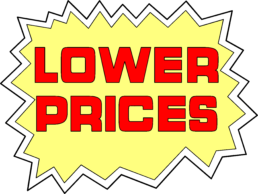Accounting Considerations for Marketing Agencies
Over the last several months, I’ve had the honor of serving as the Treasurer of Triangle AdFed. It’s a volunteer position, and a lot of work at times, but it’s given me the joy of getting to hang out with some of my favorite people: marketers.
Despite the fact that I’m in a typically uncreative industry, I do love the enthusiasm and energy of professional creatives, and I greatly admire their work. A good number of The Bookkeeper’s clients are marketing agencies or professionals, and I consider many of them close friends outside of work.
I learn so much from my marketing friends, and the only advice I can offer in-turn is related to their financial management. So, to kick off our series, I thought it would be fun to write an article about the things marketers need to take into consideration when viewing their accounting systems.
Cash-Flow
 Few industries can be as volatile and unpredictable as marketing. Trends change, Google adjusts algorithms, and marketing clients don’t always recognize the back-end work that goes into their return-on-investment. Add in high costs and challenging margins, and marketing agencies can face cash-flow problems from month-to-month.
Few industries can be as volatile and unpredictable as marketing. Trends change, Google adjusts algorithms, and marketing clients don’t always recognize the back-end work that goes into their return-on-investment. Add in high costs and challenging margins, and marketing agencies can face cash-flow problems from month-to-month.
However, there are a few strategies which can be put into place to mitigate these issues. Cash-flow is really comprised of two main components: Accounts Receivable and Accounts Payable.
On the Accounts Receivable side, there are steps marketing agencies can take to keep money coming in. The first is to have a plan in place to handle delinquent client accounts. A documented series of steps for contacting clients with overdue balances can help separate the emotions from collections practices, and can help overcome the fear of “not wanting to make a client mad”. And, particularly when clients are slow-to-pay, it is good to examine not just the on-paper profitability of the client, but the cash profitability of the client. That’s because, in marketing, a large part of Accounts Payable is tied to client activity.
On the Accounts Payable side, marketers will often have high bills (for ad spend, website design, etc.) tied directly to client projects. Ideally, you would have a client paying for these costs directly, or paying for them in advance, to improve A/P cash-flow. However, in situations where that might not be feasible, it can be wise to utilize credit for some of those large purchases, and pay the balance off in-full from cash each month. This way, in the event of a non-paying client or other emergency, there is a bit of a “cash cushion” to sustain the business for fixed expenses such as rent and payroll. There is also no shame in partnering with vendors to find a monthly payment schedule which works for the regular flow of your business; so long as they know when to expect their payment, most vendors will be happy to accommodate your preferred payment date each month.
Payroll
 Payroll is so important because it is the one thing you can absolutely never be late on. If you have employees, they are the most valuable resource of your business. And marketing companies often walk a fine line in determining when to work with employees, and when to work with subcontractors.
Payroll is so important because it is the one thing you can absolutely never be late on. If you have employees, they are the most valuable resource of your business. And marketing companies often walk a fine line in determining when to work with employees, and when to work with subcontractors.
Now, we know I can write an entire article on FLSA compliance, so I won’t bore you with reminders to pay employees as employees and vice-versa. However, for budgeting and expense-management purposes, choosing which type of worker to use can be a crucial part of a marketing agency’s growth.
Subcontractors typically come at a higher hourly rate, but can be used as often, or as sparingly, as is needed. Also, it’s easy to track client-specific costs when paying for work on a per-job basis.
Employees often come with a lower hourly rate, but they also come with employer tax liabilities, and might not be as motivated for high production efficiency if their hours are set. Also, if the market turns and sales drop, you can be put in the awkward position of having to cut hours and/or staff.
A good solution is to perform a break-even analysis of adding an additional employee vs. paying a subcontractor. You can use this to determine exactly how many hours of work necessitate additional part-time or full-time staff; you can also take into consideration such factors as production bonuses and/or commissions or profit-sharing for employees (to encourage strong work and efficiency).
Pricing
 Many industries struggle with pricing, but marketing has come unique concerns. Many clients contract marketing agencies for both project and ongoing retainer work, and tracking the associated costs for those clients (and billing accordingly) can be a major challenge.
Many industries struggle with pricing, but marketing has come unique concerns. Many clients contract marketing agencies for both project and ongoing retainer work, and tracking the associated costs for those clients (and billing accordingly) can be a major challenge.
The first step is to clearly define the parameters of retainer hours and service projects, and to monitor those closely to prevent “scope creep”. This will help you to keep costs down, and will also help prevent large, unexpected bills for clients. For clients who are paying a flat monthly fee, either have a provision in the agreement for going over hours, or regularly review client hours to see whether a retainer needs to be increased.
It is also important to have a clear definition of what clients you want to serve. There is a fine line to walk in pricing competitively and remaining profitable; recognizing that you can’t serve every client model and identifying your target market can help you walk that line.
Because marketing is such a large field, there are many other niche problems which can arise. (For example, 1099s for inf marketing, or currency conversion for international marketing.) So for marketers in particular, it’s important to work with finance professionals who understand your company and its unique needs fully. Don’t be shy about asking your bookkeeper, tax preparer, or CFO how they would address some of these issues.
Pricing Strategies: How do I know how much to charge?
To view this article in video form, visit our YouTube channel.
One of the hardest decisions a new business owner makes is how much to charge. In calculating the "right" price, there are a number of variables to consider.
 For starters, let's re-visit Intro to Microeconomics and ask, is your product elastic, or inelastic? Elastic products are those goods or services in which demand is closely tied with price. In other words, demand on an elastic product will increase with a decrease in price, and vice versa. The demand for inelastic goods is steadier, and less dependent on price.
For starters, let's re-visit Intro to Microeconomics and ask, is your product elastic, or inelastic? Elastic products are those goods or services in which demand is closely tied with price. In other words, demand on an elastic product will increase with a decrease in price, and vice versa. The demand for inelastic goods is steadier, and less dependent on price.
For example, a specific brand of chocolate chips is a highly elastic good. If the price increases too much, customers will just purchase a different brand of chocolate chip (or decide to bake a different type of cookies, or just buy the pre-made cookies outright). Though I might really like Ghirardelli brand chocolate chips, I don't really need them, and there are plenty of ready substitutes available.
A very inelastic product would be gasoline. The price tends to be relatively uniform within a geographic area, and most people are heavily reliant on it in their day-to-day lives. Even when the price surges, consumers still have to purchase a certain amount. Likewise, even when gasoline is very cheap, people don't necessarily start driving and purchasing significantly more.
If your product is elastic, you don't necessarily have to have one set price. You could employ "surge" pricing, a la Uber, and charge more when your goods or services are in greater demand. You can also try to generate increased demand through temporary price drops. (Perhaps some of you are old enough to remember "blue light specials".) If you want to keep steady prices, or if you're good is inelastic, there are other variables to consider.
To develop a pricing strategy, you should know your variable expenses, how to calculate profit margin, and have a general idea of market price (competitors' prices).
Maybe you have a surface familiarity with the terms "variable expenses" and "profit margin", but aren't 100% clear on how they're calculated. For your benefit, we'll have a quick accounting lesson.
 Variable expenses are those expenses which are directly tied to the production of each unit of a product, and might include such expenses as raw materials, labor hours, and shipping costs. In other words, variable expenses increase (or vary) as production increases. Costs of Goods Sold (or COGS) are variable expenses.
Variable expenses are those expenses which are directly tied to the production of each unit of a product, and might include such expenses as raw materials, labor hours, and shipping costs. In other words, variable expenses increase (or vary) as production increases. Costs of Goods Sold (or COGS) are variable expenses.
To calculate your profit margins, divide your net profit (sales - COGS) by your sales. Playing with these formulas at different prices can help you determine a feasible price for your product.
As far as competitive pricing, it is good to be in a range with your market competitors, though you don't necessarily have to be the cheapest, or even on the lowest end. Trying to win customers on price alone can cause a big hit to your profit margins, and will not bring you long-term success. If you cannot safely price your competitors out, beat them with a distinguished product and superior customer service.
Finally, there are discounts to consider, particularly "friends and family" pricing. Special pricing is fine, as long as you can still maintain healthy margins. Never sell at a loss, even for those close to you. You do not want to have to raise prices on friends and family later, so set them at a level you can maintain indefinitely. If you price yourself out of business, you really aren't doing your loved ones any favors.
Stop Eating Frogs
Mark Twain famously said, “Eat a live frog first thing in the morning and nothing worse will happen to you the rest of the day.” In recent years this has become a particularly popular sentiment amongst entrepreneurs, used as a reminder to not procrastinate in completing disliked chores. Small business owners typically have to manage so many different aspects of their company, it's inevitable that there will be some tasks they dread.
For many, their "frog" is accounting.
But, here's the secret...for some people, frog is a delicacy.
We may be in the minority, but, at The Bookkeeper, accounting and finance aren't just something that pays the bills. We actually find a lot of it fun.
Here are a few of our services which, though business owners typically find distasteful, we really enjoy.
 Developing Business Procedures
Developing Business ProceduresYou know the only thing more fun than reading a collections procedure manual? Writing a collections procedure manual. It combines several of the things we love, like research, technical writing, and custom-tailoring business practices to an individual company. What's not to love?
Of course, we've heard some people refer to research as "boring" or technical writing as "tedious". But we feel the same way about SEO optimization and, apparently, some people enjoy that.
Budgeting
Budgeting seems to have a negative connotation for a lot of people. A budget is seen as something constraining. But we think budgeting is awesome. You get to look at all your revenues and expenses, and figure out where you can save or earn more money. Who doesn't like having more money? A budget lets you make plans and take steps to achieve your goals. Not knowing your budget is like driving blindfolded. Maybe exciting for some, but too risky for us.

Debt Repayment Plans
A lot of people who are in a great deal of debt don't like to think about how much debt they're in. Of course, ignoring a problem doesn't make it go away.
For business owners overwhelmed by debt, figuring out a way to repay it all is too big a frog to eat. Much easier to just make the minimum payments and try not to think too hard about those rising balances. Fortunately, we love writing debt repayment plans.
Like so many problem, debt seems a lot bigger when you're in the middle of it. That's why we enjoy taking an objective, mathematical look at the problem, and coming up with a tangible, step-by-step solution to eliminating it. And it is so exciting to show someone how they can, often without even spending additional money, be debt-free and have savings built up in, frequently, as little as five years.

Profitability Analysis & Pricing Strategies
Some people may be put off from some aspects of accounting because of the math involved, particularly when it comes to things like calculating gross profit margins. We at The Bookkeeper are huge fans of math, perhaps because of its consistency and objectivity or, perhaps, as the great philosopher Cady Heron stated, "Because it's the same in every country." (Yes, both Mark Twain and "Mean Girls" quotes in one article. Small business accounting can be very culturally relevant.)
Math is especially useful when it comes to looking at which products or services provide higher revenues or greater returns, and where prices can be raised to improve profitability. Using a little bit of math and research to make more money, without having to sell more or perform more work? That's fun.

These are just a few of the services we provide for our clients, not just because our clients find them difficult or loathe doing them, but because we actually do find them interesting. Where the client sees a live frog, we see a perfectly seared filet mignon.
If there's some chore in your business which you simply despise completing on a daily basis, whether it's finance-related or something else, consider whether it's worth it to you to pay someone else to eat that frog.
You're in business for yourself, so why do something you hate?
The Financial Reasons Small Businesses Fail
Almost every entrepreneur has heard the statistic: 80% of small businesses fail. There are many reasons this happens, and can include everything from market slumps to lazy owners. To enumerate every way a business can go under would be an endless, impossible task.
However, there are a few financial characteristics frequently found in struggling businesses. Here are the most common financial reasons small businesses fail.
There's no plan. It's not uncommon to meet new small business owners who have a brilliant product idea, a well-developed marketing plan, a slick website, and not one thought given to their budget. We've already written on the tough financial questions to answer before starting your own business, but the importance of a solid financial bedrock cannot be overemphasized. A well-researched budget and fixed goals is the key to surviving that crucial first year in which most businesses go under. Great customer service and spot-on marketing are not enough to balance out shaky financials.
Speaking of customer service...

Poor credit management and pricing strategies are bad for everyone. No one craves popularity like an entrepreneur and, when your business's success is entwined with how well-liked you are, the urge to avoid offending anyone becomes even stronger. In the early days of a business, when there are only a few customers, there is a common impulse to let clients slide on late payments, or to offer frequent "friends and family" discounts. It's easy to justify this with the logic with the idea that you need to establish customer loyalty, and you can tighten the reins a bit when you have a solid customer base. There are a few reasons this doesn't work:
- Clients who don't pay on time aren't going to appreciate the slack you've given them in the past; they are going to resent the restrictions you enforce in the future.
- Likewise, your patrons who are just coming to you for the lowest price will quickly go elsewhere when your rates rise.
Lenient accounts receivable and cheap pricing might gain you a quick boost in early sales, but they are not a sustainable model. Delivering a product you can be proud of, at a price that is worth your hard work and can keep your business afloat (and actually requiring customers pay you that fair price) ensures that your customers the pleasure of patronizing your business for years to come. Because you have to remember...

Cash is king. Yes, it's a cliche, but that doesn't make it any less true. A great business model matters little if you run out of money before you can implement it. Managing cash flow is key to not just the health but the continued existence of your business. Here are a few of the most common cash pitfalls small businesses face:
1.) Insufficient capital. In all likelihood, your business will not be immediately profitable. So not only do you need enough cash to get your business started, but you need enough to allow yourself to operate at a loss for a while.
2.) Not having a large enough cash cushion. Think "Princess & the Pea" levels of padding. Regardless of how well you plan, the economy is unpredictable. Look to history for examples. No one expected the Boston Molasses flood which, in addition to the damage caused and lives lost, resulted in a nearly $11M settlement (in today's money) for the responsible company.
3.) Over-investing in fixed assets. It's great to plan for the long-term but, if you don't plan for the short-term as well, your business will not get a long-term. Sacrificing too much of your cash for something like manufacturing equipment (even if you're getting a great deal) can hurt you, as that is not a liquid asset and will be of no help to you in the event of an emergency (i.e. your factory flooding a major metropolis with 2.3M gallons of molasses). Think of it like a game of Monopoly; if you start building hotels too soon and suddenly need cash, you're stuck selling all your buildings back to the bank for half-price, and you know bankruptcy is right around the corner. Only, in real business, instead of losing yet another game to your annoying brother-in-law, you've lost your entire livelihood.
Expanding your business is the ultimate goal, but maintaining cash flow gives you the solid foundation you need to build upon.
80% of new businesses fail, but that means 20% succeed. To be that 1 out of 5, have a plan, know your value, and remain patient. Better to start small and grow something big than to start too big and dwindle away.




